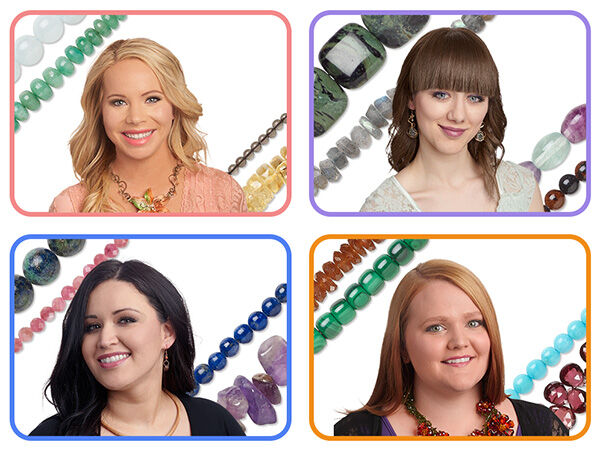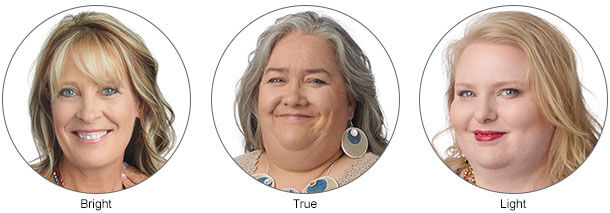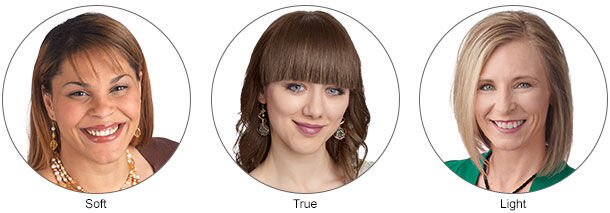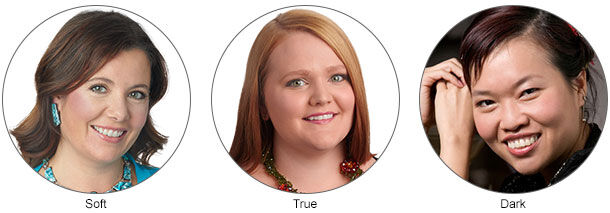Choosing Jewelry for Your Color Season
Jewelry makers often talk about color "seasons"--oranges for autumn, jewel tones for winter, pastels for spring and neons for summer. Even though those categories are no longer socially enforced, they still have a grip on our preconceptions of which colors to use when making designs for summer craft fairs.
All of those old rules are out the window--but there's one place where "seasonal colors" still apply.
Color Analysis
Color plays an important element in every design, yet not every gemstone color or metal finish looks good on every skin tone. Helping your customers understand which designs suit them isn't just a measure of suiting their hairstyle or face shape--closing the sale can also include helping them understand that red garnet doesn't suit their coloring at all, even if they are a January baby. You can encourage them to consider orange-tinted hessonite garnet or green tsavorite instead--still garnets, just garnets that suit them.
How to Discover Your Customer's "Season"
There are multiple elements to consider when doing a quick analysis of a customer's coloring. Do keep in mind that this system was developed for and by northern Europeans, so there are additional factors to consider when assisting customers of non-European origin, or who have mixed heritages. A customer with Tyra Banks' mix of warm skin tone with cool and bright eye color takes a little more time to dial in. Every color season has a wide variety of natural hair colors, eye colors and ethnicities. The best way to talk about these factors is in terms of what colors look harmonious on each individual.
While people mostly know about the four basic color seasons of Spring, Summer, Autumn and Winter, color analysis theory has expanded since the original process began in the '60s. Popular analysis includes a dozen types--three sub-types for each "season"--making the process more accurate and applicable to modern populations.
The ideal light for color analysis is mid-morning sunlight. However, if you are indoors, then a lamp with a full-spectrum light bulb will help you choose more accurately. Keep one on hand anyway, so your customers can see how different gemstone or glass materials look under different lighting.
Natural hair color
The beginning is your customer's natural hair color. This is usually obvious in the brow area, even if their mane of locks has been colored or enhanced. The four general categories for natural hair color tend to be:
- Blonde
- Brunette
- Ginger (bright red) and Auburn
- Sable (black) and Grey
If your customer's natural hair color tends to be lighter than medium brown, they're usually a Spring or Summer. If it's darker, they're generally an Autumn or Winter.
Eye Color
The second part of a quick color analysis is in the eyes. Brighter eyes will tip a customer into one general category or another, and determine if they are a Light, Dark, Bright, True or Soft version of that season. The six general categories for eye color tend to be:
- Blue
- Brown
- Gold
- Green
- Grey
- Hazel
Remember, this is your customer's natural eye color. Colored contacts will make analysis more difficult--so can brightly colored eyeglass frames.
Skin Tone
Don't be confused and think this is about skin color --it's about skin tone . Does their skin have an olive undertone that makes their veins look greenish, pink undertone that makes their veins look purple or are they one of those true neutrals where the veins are just a shade of blue (light or dark)?
Skin tone is probably the most influential factor in color analysis, as it encompasses the secondary portion of color analysis: the seasonal modifiers. Those modifiers each apply to only two of the four original seasons:If your customer's coloring doesn't suit a "pure" version of the season (called "true" in this article), this will help you and them identify which neighboring color seasons to look to for additional hues.
- Bright
- Soft
- True
- Light
- Dark
The 12 Color Seasons (in brief)
Spring
Bright Spring
- Natural hair color tends to be light (blonde/"dishwater" blonde/light brown)
- Skin tone is neutral for their ethnicity
- Eyes tend to be light and intensely colored
- Ideal colors are bright, medium saturation and slightly warm in hue
- Ideal neutrals are warm black or charcoal grey
- Ideal metal tones are silver and gold
- Suggested gemstone colors are pink and red corals, aquamarines, golden topaz and peridot
True Spring
- Natural hair color tends to be light (blonde/strawberry blonde/light brown)
- Skin tone is warm for their ethnicity
- Eyes tend to be light, but not intensely, colored
- Ideal colors are medium-to-high intensity, medium saturation and deeply warm in hue
- Ideal neutrals are warm browns
- Ideal metal tone is gold
- Suggested gemstone colors are emeralds, smoky quartz, citrine and alexandrite
Light Spring
- Natural hair color tends to be extremely light (flaxen or platinum blonde)
- Skin tone is neutral for their ethnicity
- Eyes are pale
- Ideal colors are pale, medium intensity and slightly warm
- Ideal neutral is taupe
- Ideal metal tones are silver and gold
- Suggested gemstone colors are pink and salmon corals, blue and green aquamarines, lapis lazuli and smoky quartz
Summer
Soft Summer
- Natural hair color tends to be medium ("dishwater" blonde, light to medium brown)
- Skin tone is neutral for their ethnicity
- Eyes tend to be light to medium color intensity (especially hazel)
- Ideal colors are muted, medium saturation and slightly cool
- Ideal neutral is taupe
- Ideal metal tones are antiqued silver and gold
- Suggested gemstone colors are mahogany obsidian, tiger iron, labradorite and rhyolite
True Summer
- Natural hair color tends to be medium (medium brown, no auburn)
- Skin tone is cool for their ethnicity
- Eyes tend to be blue, green or grey
- Ideal colors are cool, medium intensity and medium saturation
- Ideal neutral is cool grey
- Ideal metal tones are silver and gunmetal
- Suggested gemstone colors are African "jade," Kambaba jasper, dark amethyst and pietersite
Light Summer
- Natural hair color tends to be medium ("dishwater" blonde, light to medium brown)
- Skin tone is neutral for their ethnicity
- Eyes are light to medium color intensity (especially hazel)
- Ideal colors are light, low-to-medium intensity and slightly cool
- Ideal neutral is taupe
- Ideal metal tones are silver and gold
- Suggested gemstone colors are hot pink corals, green aventurine, aquamarine and fluorite
Autumn
Soft Autumn
- Natural hair color tends to be medium to dark with red or orange tones
- Skin tone is neutral for their ethnicity
- Eyes tend to be medium color intensity (especially hazel)
- Ideal colors are muted, medium saturation and slightly warm
- Ideal neutral is khaki
- Ideal metal tones are silver and gold
- Suggested gemstone colors are tigerskin "jasper," indosolite garnet, kyanite and dark amethyst
True Autumn
- Natural hair color tends to be medium red (aka "ginger")
- Skin tone is warm for their ethnicity
- Eyes tend to be medium color intensity
- Ideal colors are warm, medium-to-high saturation and medium intensity
- Ideal neutral is taupe
- Ideal metal tone is gold
- Suggested gemstone colors are Sleeping Beauty turquoise, salmon coral, hessonite and green malachite
Dark Autumn
- Natural hair color tends to be dark with red or orange tones
- Skin tone is neutral for their ethnicity
- Eyes tend to be high color intensity, with greens and blues dominating
- Ideal colors are high saturation, medium-to-high intensity and slightly warm
- Ideal neutral is warm black
- Ideal metal tones are silver and gold
- Suggested gemstone colors are dark amethyst, green onyx, opal and rhodolite garnet
Winter
Bright Winter
- Natural hair color tends to be medium to dark
- Skin tone is neutral for their ethnicity
- Eyes tend to be high color intensity, with greens and blues dominating
- Ideal colors are medium-to-high saturation and slightly cool
- Ideal neutral is crisp white
- Ideal metal tones are silver and gold
- Suggested gemstone colors are pink and red corals, Sleeping Beauty turquoise, golden agate and tsavorite garnet
True Winter
- Natural hair color tends to be dark (black hair has blue undertones)
- Skin tone is cool for their ethnicity
- Eyes tend to be dark with high color intensity
- Ideal colors are cool, medium-to-high intensity and medium-to-high saturation
- Ideal neutrals are crisp white and true black
- Ideal metal tones are silver
- Suggested gemstone colors are rhodochrosite, pink tourmaline, green malachite and sapphire
Dark Winter
- Natural hair color tends to be dark
- Skin tone is neutral for their ethnicity
- Eyes tend to be dark
- Ideal colors are high saturation, medium intensity and slightly cool
- Ideal neutrals are crisp white and true black
- Ideal metal tones are silver and gold
- Suggested gemstone colors are red coral, amethyst, chrysocolla and lapis lazuli (not denim lapis)
A great place to start, for more research and a better understanding of how to choose colors that work, is the updated edition of Color Me Beautiful by Carol Jackson.
Have a question regarding this project? Email Customer Service.
Copyright Permissions
All works of authorship (articles, videos, tutorials and other creative works) are from the Fire Mountain Gems and Beads® Collection, and permission to copy is granted for non-commercial educational purposes only. All other reproduction requires written permission. For more information, please email copyrightpermission@firemtn.com.




